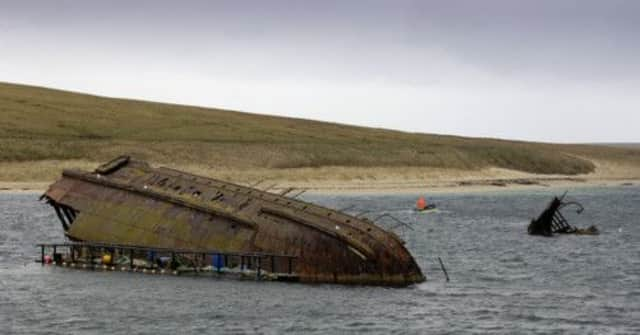Wartime Orkney marine wrecks to be surveyed


Previous surveys have focused on the seabed of Scapa Flow where the 74 warships of the German High Seas Fleet was scuttled in 1919 in the largest intentional sinking in worldwide naval history.
But the new survey will be focused on the remains of the “blockships” around the islands’ Churchill Barriers first sunk to help protect the British fleet anchored in Scapa Flow from enemy attack.
Advertisement
Hide AdA Historic Scotland spokeswoman explained: “The surveys will provide information on the extent, survival and condition of a number of marine cultural heritage sites that have not been recorded by previous work around the islands.
“Orca Marine, a department of Orkney College and Sula Diving, will target sites which will be recorded using a side-scan sonar and then dived on to identify the nature and character of the remains. The work will focus on the remains of blockships around the Churchill Barriers and a number of other sites in and around the Gutter Sound.”
She added: “It will also help Historic Scotland to consider the case for a Historic Marine Protected Area focused on the wartime underwater remains in the Flow.”
Last year, Historic Scotland commissioned sonar surveys of the sea bed revealing new details of scuttled merchant ships from both the First and Second World Wars. It also identified a German submarine and a trawler used to operate boom defences at the entrance to Scapa Flow. Scapa Flow was the home base for the Royal Navy’s Grand Fleet in the First World War and, the northern base for the Home Fleet in the Second World War.
Andrew Fulton, the Senior Designations Officer with Historic Scotland said: “Scapa Flow was used in both world wars as a main harbour for the Royal Navy.
Historians and archaelogists have increasingly recognised the diversity of remains on the seabed. This work will increase our understanding of Scapa flow’s marine heritage sites and fill the gaps in our mapping.
Advertisement
Hide Ad“The sites are deteriorating and this makes the case for recording them even stronger. This will enhance our understanding of the historic marine environment and provide an up-to-date record of important sites”
Dr Annalisa Christie, a marine archaeologist with ORCA Marine, said: “As a local company ORCA Marine are aware of the importance of the wartime heritage in Scapa Flow to the local community and the tourism sector.
Advertisement
Hide Ad“In leading this project, we are excited to be involved in the recording and potential identification of sites, and helping to preserve these sites to the benefit of local businesses, community members and dive boat operators.”
Previous seabed surveys by the ScapaMap project between 2001 and 2006, have helped to record the remaining light cruiser and /battleship wrecks of the High Seas Fleet, designated as scheduled monuments, the salvage sites of the German High Seas Fleet north and west of Cava island, and the remains of HMS Vanguard.
The new marine surveys will be taking place in Scapa Flow between 21 October and 30 November. During the First World War, anti-submarine netting was suspended across some of the larger channels into Scapa Flow and the blockships were deliberately sunk in the smaller channels.
By the dawn of the Second World War the defences had fallen into disrepair and Winston Churchill ordered the construction of several permanent “Churchill” barriers to prevent any further attacks after a German U boat penetrated the defences and torpedoed and sank the battleship Royal Oak with the loss of over 800 lives.
A diving website states: “These blockships now offer great shallow wreck dives. They are often used as training sites – allowing divers to refine their skills before visiting the deeper wrecks of the German High Seas Fleet in the heart of Scapa Flow. “